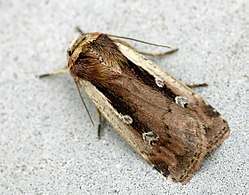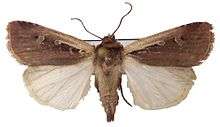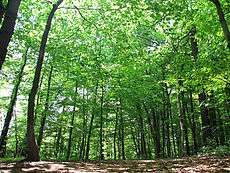Flame shoulder
The flame shoulder (Ochropleura plecta) is a moth of the family Noctuidae. The species was first described by Carl Linnaeus in 1761. It is distributed throughout the Palearctic from Ireland in the west to Siberia then Korea and Japan in the east.
| Flame shoulder | |
|---|---|
 | |
 | |
| Scientific classification | |
| Kingdom: | |
| Phylum: | |
| Class: | |
| Order: | |
| Family: | |
| Genus: | |
| Species: | O. plecta |
| Binomial name | |
| Ochropleura plecta (Linnaeus, 1761) | |
| Synonyms | |
| |
The forewings of this species are reddish brown with a black streak interrupted by white stigmata and a creamy-yellow streak along the costa which gives the species its common name. The hindwings are pure white.
Technical description and variation
The wingspan is 28–34 mm. Forewing red brown suffused with purple; costal streak broadly cream colour to outer line, sometimes red speckled; cell and a basal streak below median vein blackish or deep red; orbicular and reniform stigmata with bright pale rings and grey centres, the latter followed by a small black blotch; lines rarely visible; hindwing whitish; patagia red-brown; dorsum greyish fuscous, sometimes with basal half cream coloured, sometimes wholly cream coloured. The ab. unimacula Stgr. [now ssp.] from Spain has the orbicular stigma obsolete; — in ab. anderssoni Lampa from Scandinavia the forewing is blackish purple; in ab. glaucimacula Graes. from Amurland the stigmata are smaller, as in leucogaster Frr. [now full species] and pearl grey in colour; the outer line of forewing well marked and indicated on hindwing also by vein-dots; patagia black brown; — ab. ignota uncertainly ranked by Swinh., described in the first instance from Sri Lanka, has the cell red like the rest of wing; European examples of this form are generally entirety pale red, with the costal streak red-speckled and usually females.[1]
Biology
Two broods are produced each year with adults flying from April to June and again in August and September.[2] It flies at night and is attracted to light and sugar and also to the flowers of ragwort.
The caterpillar is brownish. Ventral area yellowish. There are fine dark line found on dorsal area. Stigmata black in color.[3]
The larva, grey with a yellow stripe along each side, feeds on a range of plants (see list below). This species overwinters as a pupa.

Recorded food plants
- Arachis – peanut
- Aster
- Beta – beet
- Galium – bedstraw
- Plantago – plantain
- Rumex – docks and sorrel
- Salix – willow
- Senecio – groundsel
- Trifolium – clover
See Robinson, G. S et al.[4]
Subspecies
- O. p. plecta – Europe except Iberian Peninsula
- O. p. unimacula – Iberian Peninsula
Notes
- Seitz, A. Ed., 1914 Die Großschmetterlinge der Erde, Verlag Alfred Kernen, Stuttgart Band 3: Abt. 1, Die Großschmetterlinge des palaearktischen Faunengebietes, Die palaearktischen eulenartigen Nachtfalter, 1914
- The flight season refers to the British Isles. This may vary in other parts of the range.
- Hampson, G. F. (1894). The Fauna of British India, Including Ceylon and Burma: Moths Volume II. Taylor and Francis – via Biodiversity Heritage Library.
- "Robinson, G. S., P. R. Ackery, I. J. Kitching, G. W. Beccaloni & L. M. Hernández, 2010. HOSTS – A Database of the World's Lepidopteran Hostplants. Natural History Museum, London".
References
- Chinery, Michael Collins Guide to the Insects of Britain and Western Europe 1986 (Reprinted 1991)
- Skinner, Bernard Colour Identification Guide to Moths of the British Isles 1984
External links
| Wikimedia Commons has media related to Ochropleura plecta. |
- "73.329 BF2102 Flame Shoulder Ochropleura plecta (Linnaeus, 1761)". UKMoths. Retrieved January 15, 2019.
- Savela, Markku. "Ochropleura plecta (Linnaeus, 1761)". Lepidoptera and Some Other Life Forms. Retrieved January 15, 2019.
- "10086 Ochropleura plecta (Linnaeus, [1760]) - Hellrandige Erdeule". Lepiforum e.V. Retrieved January 15, 2019.